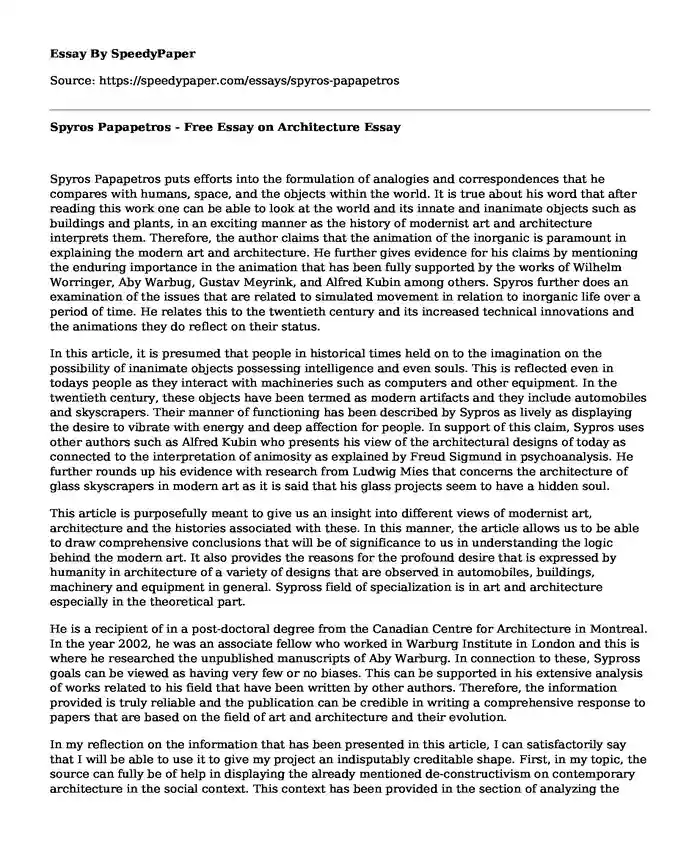
| Type of paper: | Essay |
| Categories: | Architecture Design Personality |
| Pages: | 3 |
| Wordcount: | 764 words |
Spyros Papapetros puts efforts into the formulation of analogies and correspondences that he compares with humans, space, and the objects within the world. It is true about his word that after reading this work one can be able to look at the world and its innate and inanimate objects such as buildings and plants, in an exciting manner as the history of modernist art and architecture interprets them. Therefore, the author claims that the animation of the inorganic is paramount in explaining the modern art and architecture. He further gives evidence for his claims by mentioning the enduring importance in the animation that has been fully supported by the works of Wilhelm Worringer, Aby Warbug, Gustav Meyrink, and Alfred Kubin among others. Spyros further does an examination of the issues that are related to simulated movement in relation to inorganic life over a period of time. He relates this to the twentieth century and its increased technical innovations and the animations they do reflect on their status.
In this article, it is presumed that people in historical times held on to the imagination on the possibility of inanimate objects possessing intelligence and even souls. This is reflected even in todays people as they interact with machineries such as computers and other equipment. In the twentieth century, these objects have been termed as modern artifacts and they include automobiles and skyscrapers. Their manner of functioning has been described by Sypros as lively as displaying the desire to vibrate with energy and deep affection for people. In support of this claim, Sypros uses other authors such as Alfred Kubin who presents his view of the architectural designs of today as connected to the interpretation of animosity as explained by Freud Sigmund in psychoanalysis. He further rounds up his evidence with research from Ludwig Mies that concerns the architecture of glass skyscrapers in modern art as it is said that his glass projects seem to have a hidden soul.
This article is purposefully meant to give us an insight into different views of modernist art, architecture and the histories associated with these. In this manner, the article allows us to be able to draw comprehensive conclusions that will be of significance to us in understanding the logic behind the modern art. It also provides the reasons for the profound desire that is expressed by humanity in architecture of a variety of designs that are observed in automobiles, buildings, machinery and equipment in general. Sypross field of specialization is in art and architecture especially in the theoretical part.
He is a recipient of in a post-doctoral degree from the Canadian Centre for Architecture in Montreal. In the year 2002, he was an associate fellow who worked in Warburg Institute in London and this is where he researched the unpublished manuscripts of Aby Warburg. In connection to these, Sypross goals can be viewed as having very few or no biases. This can be supported in his extensive analysis of works related to his field that have been written by other authors. Therefore, the information provided is truly reliable and the publication can be credible in writing a comprehensive response to papers that are based on the field of art and architecture and their evolution.
In my reflection on the information that has been presented in this article, I can satisfactorily say that I will be able to use it to give my project an indisputably creditable shape. First, in my topic, the source can fully be of help in displaying the already mentioned de-constructivism on contemporary architecture in the social context. This context has been provided in the section of analyzing the argument of both Afred Kubin and Ludwig Mies as discussed by Sypros. Moreover, the case study of the uncanny architecture in urban Parks, Bernard Tschumis Parc de la Villette in Paris, France, considered my project is suitable.
The work of Tschumi on uncanny contemporary architecture and that of Sypros in this article do complement each other in that they both discuss architectural designs and their evolution. However, the two challenge each other in the context of an existing crisis in architectural designs. The crisis lies within the shifting to new social designs of handling architecture and it is a point that has been suggested by Tschumi. On the other hand, Sypros does concur to the implementation of new social designs in this century although he insists that the historical ones should be considered as well.
Work Cited
Papapetros, Spyros. 'Malicious Houses: Animation, Animism, Animosity In German Architecture And FilmFrom Mies To Murnau'. Grey Room 20 (2005): 6-37. Web
Cite this page
Spyros Papapetros - Free Essay on Architecture. (2019, May 14). Retrieved from https://speedypaper.net/essays/spyros-papapetros
Request Removal
If you are the original author of this essay and no longer wish to have it published on the SpeedyPaper website, please click below to request its removal:
- Essay Example: Physical Wellness Assignment
- Free Essay: Quality Assurance Processes for the Accounting Department in IT business
- Law School Entrance Essay Sample
- Essay Example Describing Self-Stigma and Social Stigma
- Essay Sample on The Leadership of Qin Shi Huang
- Essay Sample on Comparison Between U.S. and Switzerland's Healthcare Systems
- Free Essay on Special Considerations for Addictions and Treatment Among Women
Popular categories




